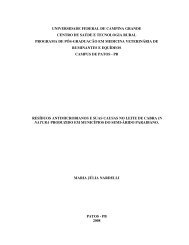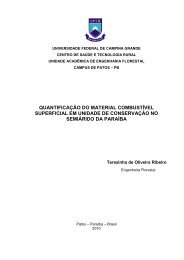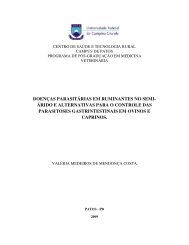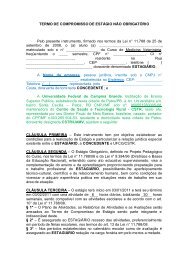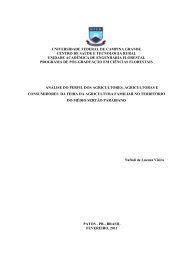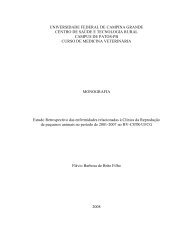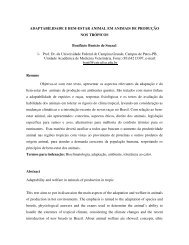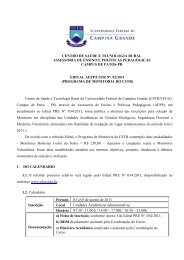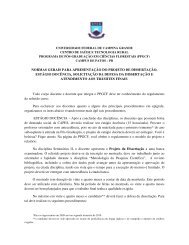UNIVERSIDADE FEDERAL DE CAMPINA GRANDE - Cstr.ufcg.edu.br
UNIVERSIDADE FEDERAL DE CAMPINA GRANDE - Cstr.ufcg.edu.br
UNIVERSIDADE FEDERAL DE CAMPINA GRANDE - Cstr.ufcg.edu.br
You also want an ePaper? Increase the reach of your titles
YUMPU automatically turns print PDFs into web optimized ePapers that Google loves.
ABSTRACTNUNES, Shirley Tavares Nunes. Recovery of degraded Caatinga sites by planting thornyand thornless varieties of the native tree species Mimosa tenuiflora and Cnidoscolusquercifolius). Patos-PB: UFCG, 2012. 74 sheets. (Dissertation – M.Sc. in Forest Sciences).2012.Among the activities carried out in the semiarid region of northeast Brazil, agriculture andcattle raising cause most of the environmental impacts, especially on the vegetation. Naturalregeneration of the vegetation in degraded Caatinga sites is very slow, and humanintervention is necessary. This study compared the effects of the thorny and thornless varietiesof two native trees (Mimosa tenuiflora and Cnidicoscolus quercifolius) on the recovery ofdegraded Caatinga sites during three consecutive growing seasons, by collecting data onlength and basal diameter of the two planted trees, soil cover by herbs and tree canopy,production and quality of herb and tree forage, and chemical and physical soil attributes.Control plots (no tree planting and <strong>br</strong>owsing, although <strong>br</strong>owsing was allowed in some controlplots) were established close to the experiment for comparisons purposes. Naturalreestablishment of herb cover is observed in the first year when <strong>br</strong>owsing is not allowed,while natural reestablishment of tree cover on <strong>br</strong>owsed or non-<strong>br</strong>owsed plots showed to beinexistent or incipient and results from thorny M. tenuiflora individuals only. Recovery of treecover can be accelerated by planting native trees, especially M. tenuiflora. Its fine <strong>br</strong>anchescan be pruned in the third growing season after planting to collect forage and to r<strong>edu</strong>ceshadowing that turned to be detrimental to production of herb forage. Thorny and thornlessvarieties of M. tenuiflora showed no significant differences. Positive effects from C.quercifolius were observed on herb growth and production, although no fine <strong>br</strong>anches werepruned as its canopy growth was not enough to affect negatively herb species. Thorny C.quercifolius showed higher survival and growth than its thornless counterpart, and geneticimprovement should be carried out on these characters before this variety can beadvantageously used. Animal deferment and tree planting resulted in improvements on soilattributes, especially on soil field capacity and density. Further researches should be carriedout to check some observed trends, such as the increase in soil OM and available P, and thedecrease in soil K to choose the appropriate management soil and vegetation practices toeffectively reinsert the degraded area into the productive system. Planting of thornless M.tenuiflora and thorny C. quercifolius in areas where no <strong>br</strong>owsing is allowed is an effectiveway to recover degraded Caatinga sites, and result in high levels of soil cover, increase inforage quantity and quality, and amelioration in some soil attributes such as density and waterstorage capacity. These improvements certainly help in the sustainability of the cattle raisingactivity in the Caatinga.Keywords: Plant cover. Forage quantity and quality. Soil atributes. Semiarid.



